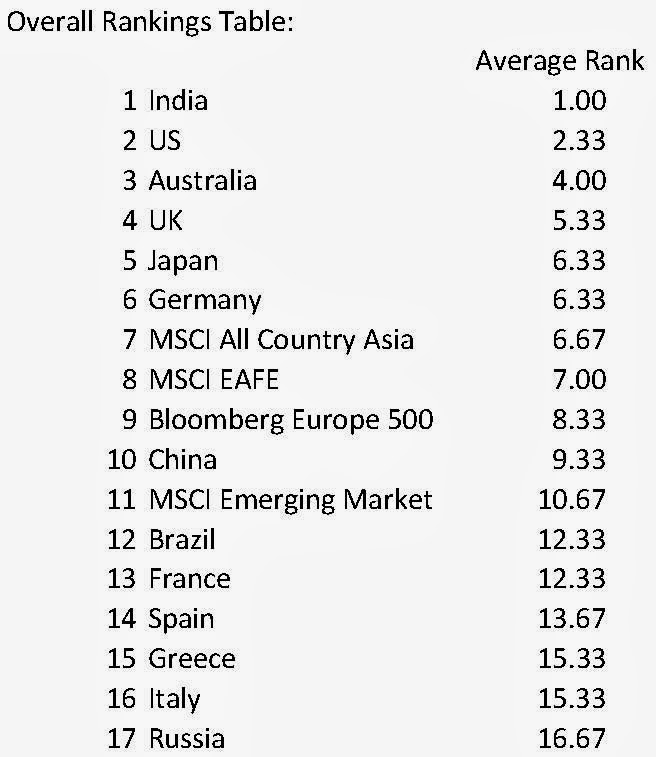Once again, it’s been a few months since we updated our valuation tables. As in the past, we’ve included stock market indices for 13 countries across the developed and emerging market spectrum. We also throw in a few developed and emerging market indices to show how the broader international areas/regions stack up against one another. We take three indicators broadly used by many value-oriented practitioners—10-Year CAPE P/E, Price to Book, and Enterprise Value to EBITDA—rank the countries in each category from highest valuation (relative overvaluation) to lowest valuation, then average across the categories to provide an overall score to determine position. The lower the average score, the higher the relative overvaluation and vice-versa. All ratios are based fundamental data provided by Bloomberg.
Here are updated results as of 10/4/13:
Valuation Conclusions:
- While the overall MSCI Emerging Market index has taken a relative beating this year, reflected in the fact that the MSCI Emerging Market Index sits in the lower portion of the table, India remains the most overvalued across all three indicators on a relative basis. Among the BRIC country indices, the India SENSEX Index has held up reasonably well over time. Brazil, Russia, and China indices are all decently below 2008 highs, but the SENSEX has held its ground, even though overall economic and market prospects have become cloudier. Perhaps the valuation tables above indicate that Indian markets will play catch up and pay a price over the next several years in terms of poor relative performance.
- The US comes in at a close second to India in terms of relative overvaluation. We’ve discussed in past valuation posts and in our chartbook that historical analysis shows that future 10-year total annualized returns for the US are predicted to fall three to four percentage points below the long-term historical average per annum. Australia, UK, and Japan round out the top five portion of the table when it comes to individual countries. Japan has witnessed a phenomenal run over the past year on the back of the Abenomics announcements. Fundamentals are going to have to start catching up, though, for momentum to continue. Japanese markets have basically moved sideways over the past five to six months and momentum is waning. Australia benefitted mightily from China’s growth over the past decade. There could be a moment of truth for Australian investors as markets adjust to new realities about China’s future economic path. The UK has rallied in recent years, but equity market prices have remained ahead of broader economic realities.
- Within the developed market category, France, Spain, Italy, and Greece continue to occupy the bottom spots, ex-Russia. Valuations have recovered off the rock-bottom levels observed during the main portion of the European crisis. Still, markets continue to price in significant pessimism. These markets have a strong chance of providing outsized relative returns over the next decade, if history is any guide. Economic momentum is beginning to turn in the periphery countries. Like an individual value stock, all it takes is a few better than expected economic surprises to attract investor capital into the vacuum.
- Looking at the broader indices, the MSCI EAFE, representing developed markets ex-US, scores better than the United States, while the Emerging Markets Index remains the most attractively valued on a relative basis. Breaking down regional international indices, Europe scores better than Asia.
- Russia continues to occupy the bottom of the table. Like the broader Emerging Markets Index, Russia’s equity markets have basically treaded water since 2006/2007 performance wise. Nonetheless, Russia has rarely been able to command robust valuation multiples over time. Russia’s reputation among international equity investors remains very spotty due to numerous issues surrounding trust, corporate governance, misappropriation, corruption, and other issues.
- Based on valuation alone, we’d still argue that Emerging Market equities should provide better overall total returns over the next decade compared to their developed counterparts, though investors would probably be wise to also look beyond the BRIC countries for opportunities. Within developed, we continue to believe that European equities will outperform their Asian or US counterparts over the next several years, most likely driven by rebounds in the periphery. Again, as the southern European economies begin to show signs of stabilization, there could be significant room for multiple expansion.
- Our standard “disclaimer” applies as usual. Many fundamental indicators prove their efficacy over multi-year time frames and, thus, shouldn’t be considered great short-term timing indicators. Don’t take this as indication that we expect Indian markets to collapse 50% over the next 12 months, or that we expect Italian markets to skyrocket. From this point forward, over time, history shows the odds work against the countries/indices at the top of the table and for the ones at the bottom.




